
DON CRISTINO JAVELLANA Y LOPEZ
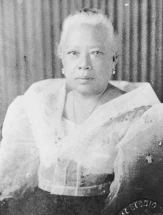
Hermenigilda Hinolan, second wife of Don Cristino Javellana
Little is known about Don Cristino Javellana, goberdanorcillo of the then city of Jaro, Iloilo during the late 1890s. He owned a brick factory — the Fábrica de Ladrillo C. Javellana — and had also served as cabeza de barangay before he was elected mayor.
In 1893, the Maura law was passed with the aim of making the municipal governments in the Philippine Islands more effective and autonomous. One of the changes that this law brought about was the reorganization of certain structures of town governments, among which was the designation of town head’s title, that is, gobernadorcillo, also as capitan municipal, effective 1895. Thus, Cristino Javellana was fondly called Capitan Tinong.

Signature of Don Cristino Javellana
The limited information extracted from memories depicts him as a deeply religious man, a very devout Catholic and a benefactor of the church. From these few stories, it was learned that he was among those who helped build the Saint Elizabeth of Hungary Metropolitan Cathedral, which was started in 1869 after Pope Pius IX decreed the establisment of the Diocese of Jaro (now the Archdiocese of Jaro).
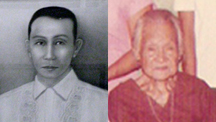
Mayor Melquiades Javellana and Socorro Javellana
Cristino Javellana (born c. 1850) married twice — first, to Baldomera Ledesma (born 26 February 1851), and second, to Hermenigilda Hinolan. By his first wife, he had five children — Juana (born 26 December 1870), Perpetua (born 8 April 1873, Note: Her baptismal record described her race as “white”), Maria Cecilia (born 22 November 1874, died 1959 in New Zealand), Melquiades (He served as Municipal President of Buenavista, Guimaras from 1917 to 1919) and Cirilo (1886-1911). Juana married Celerino Grecia, Perpetua married Antonio Alfaras, Maria Cecilia married William Henry Page, Esq. (born 1870 in New Zealand), Melquiades married Paz Darroca, and Cirilo married Felisa Rosales.
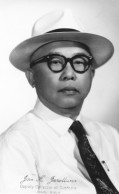
Jose Javellana
By his second wife, Cristino Javellana had six children — Maria Consolacion (born 30 August 1891), Candido (born 22 September 1892), Rosario Dionicia (born 14 October 1895), Fernando (born 30 May 1894), Socorro (born 12 September 1896) and Jose (born 18 March 1898). Consolacion married Cirilo Punzalan, Candido married Feliza Saarenas, Rosario married Pedro Pama (date/place of marriage: 23 April 1924/Pototan, Iloilo), Socorro never married, while Jose married Cresenciana Papas (date/place of marriage: 1 March 1925/Talisay, Cebu).
Cristino Javellana was the sixth of the ten children of Don Manuel Javellana (born 1815) and Doña Gertrudis Lopez (born 1819). His siblings were Escolastica (married to Geronimo Jiz de Ortega), Petra (married to Sixto Golez), Quintina (b. 1840, married to Vicente Gonora), Narcisa (b. 1842, married to Simon Grecia), Inocencia (born 1849, married to Juancho Jamora), Mariano (b. 1851, married to Crispina Gamboa), Cristeta, Carmen (married to Miguel Jayme y Lopez) and Marcelina (married to Victoriano Catagui).
To honor Cristino Javellana’s contribution to the Church, his remains were interred in one of the 12 columns along the aisle of the St. Elizabeth of Hungary Metropolitan Cathedral in Jaro, together with his son Cirilo. Carved in the gravestone are the following:
RESTOS MORTALES DE
D. CRISTINO Y CIRILO JAVELLANA
(Mortal remains of D. Cristino and Cirilo Javellana)
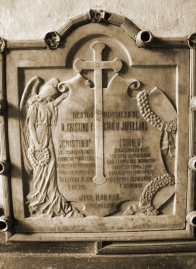
The tomb of Cristino Javellana and his son Cirilo found in one of the columns inside the Jaro Metropolitan Cathedral.
D is the abbreviation for the title Don, an honorific title during the Spanish colonial period for someone who is wealthy or who has been elected into public office. His title Don and his having served as gobernadorcillo indicate that Cristino Javellana was a principalía, a member of the ruling class in Jaro, which became a city in 1886 until 1904 when it was downgraded back into a municipality by the Americans.
The gobernadocillo was elected from among the ranks of the principalía by twelve senior cabezas de barangay. He was the primus inter pares of the cabezas of a confederation of barangays that made up a municipality. Cristino Javellana was also referred to as a cabeza de barangay in other documents.
Seventy-four people were interred inside the Jaro Cathedral — 67 were lay persons and 7 were former bishops of Jaro. According to Armando Suñe, author of The Lapidas of Jaro Cathedral (2009), Cristino Javellana and the 73 others were given “esteemed places” inside the Cathedral because of their “admirable deeds of philanthropy, religious piety and dedication to the Church, particularly their significant contribution in building this beautiful and sturdy Cathedral, the home and sanctuary of Our Lady of Candles.”
Below the name Cristino in the gravestone, the following are carved:
DESCANSA EN PAZ!
SOBRE TU TUMBA LAS
FLORES DEL RECUERDO
NUNCA SE MARCHITAN
TU ESPOSA, HIJOS Y NIETOS
(Rest in Peace! The flowers that bloom in your grave will keep your memory forever. Your wife, children and grandchildren.)
There is a common dateline in the tombstone that reads “JARO, ILOILO, I. F., FEBRERO 4, 1918”, the day their remains were transferred from their respective tombs outside of the church to their final resting place inside the cathedral. “I. F.” stands for “Islas Filipinas”.
When facing the altar, the tomb that hosts the remains of Cristino and Cirilo Javellana can be found on the fourth column at the left side of the aisle from the front entrance, near the third station of the Via Crucis (Jesus falls for the first time). On the same column can be found the tomb labeled “FAMILIA JULIO JAVELLANA” hosting the remains of Maximo Jalandoni and his sister Sofia Jalandoni de Javellana, second wife of Julio Javellana, a cousin of Cristino Javellana.
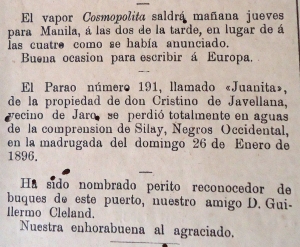
El Porvenir de Bisayas
29 Enero 1896
